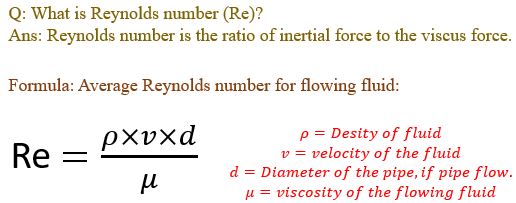What is Reynolds Number: In simple words, It is the ratio of inertial force to the viscous force.

Units of Reynolds Number: Reynolds number is a dimensionless number hence it has no units
You may find this definition everywhere but do you know what is inertial force actually means? do you know what is viscus force? do you know Reynolds number is different for mixing in a tank than Reynolds number in a pipe flow?
There are a lot of many questions hitting your mind related to Reynolds numbers, and I can present here even more so hold tight I am taking you to through all one by one.
Reynolds number
First lets check the terms used in the definition of Reynolds number.
Terms used in defining Reynolds number
- System: A system is nothing but a defined boundary under which we do our engineering study. In other words, a small part of any target on which we are going to apply our Mass, Energy, and Momentum transfer fundamentals. For example, a small piece of pipe through which fluid is flowing and fluid behavior is under study
- Inertial force: The force we apply on the system or a force applied by surrounding any equipment on the system to cause some movement.
- Viscus force: A resisting force by a fluid against the inertial force. Viscus force comes in a fluid due to the entanglement of the particles which resist the motion on the application of any external force.
- Viscosity: Viscosity is a property of a fluid to quantify viscus force(resisting force) that fluid can possess under the action of applied force.
Define Reynolds number
Reynolds number is defined as the ratio of inertial force to viscous force. Reynolds number helps us to define the regime in which fluid is flowing-
- Laminar
- Transition
- Turbulent
How to calculate Reynolds number (Derivation of Reynolds number)

Now the question comes why there is a need to define a flow regime?
Flow regimes in fluid mechanics
In fluid mechanics, we deal with fluid at rest in one section and fluid in motion in another part. Whenever fluid is in motion at a certain geometry/system if fluid is moving with fixed velocity and unchanged density and viscosity value, it shows a particular kind of behavior that behavior defines how energy and mass are going to transfer from one specified point to another.
Do you have a question in your mind about how Reynolds number is affecting heat and mass transfer? If Yes, Do comment below and let me know i’ll come up with more in-depth over this topic.
Over a period of time researchers have studied all these mechanics for different kinds of systems and shared Reynold number values for laminar, transition, and turbulent regime. I’ll tell you about very common so that you can relate it easily to your daily life.
- Water flowing through a pipe- internal flow
- Water flowing in a river- open flow
Flow regimes in pipes
When a fluid is flowing through a pipe-
| Sr. No. | Flow Regime | Reynolds Number (Re) |
|---|---|---|
| 1 | Laminar | Re less than equal to 2300 |
| 2 | Transition | 2300<Re up to 4000 |
| 3 | Turbulent | Re>4000 |
Types of Reynolds Number
The basic definition of the Reynolds number remains the same that is inertial force to viscous force but where you are applying it varies and leads to 3 main types of Reynolds numbers, these are-
- Reynolds number for flowing fluid
- Reynolds number for particle
- Reynolds number in mixing
Reynolds number-FAQs
Reynolds number’s formula is Re=(pvL)/(dynamic viscosity), where p=density, v=velocity, L=Characteristic length. Reynols number has no units because it is a dimensionless number.
In a pipe flow, if Reynolds number is <2300 then the fluid flow is considered to be laminar flow.
If Reynolds number is between 2000 and 4000, Fluid flow is in a transition state.
We can find out whether fluid flow is laminar or turbulent with the help of Reynolds number. For a fluid flowing in a pipe, If Reynolds number value comes out to be <2300 then fluid is flowing in a laminar flow. On the other side, If the Reynolds number value comes out to be >4000 then the fluid is considered to be in a turbulent flow.